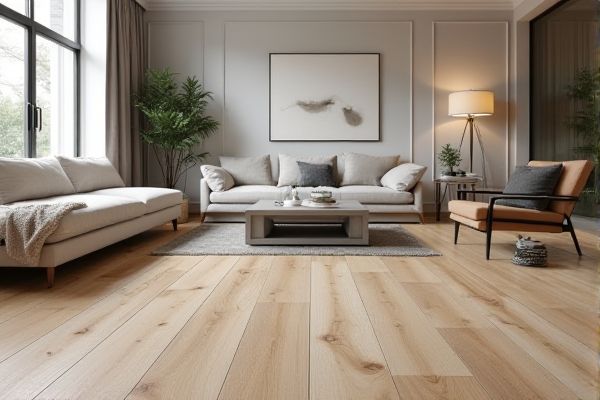
Vinyl planks offer a cost-effective, water-resistant flooring option with easy installation and a warm, comfortable feel underfoot, while ceramic tiles provide exceptional durability, heat resistance, and a wide variety of styles for high-traffic or moisture-prone areas. Discover which flooring type suits Your space best by exploring the detailed comparison ahead.
Table of Comparison
| Feature | Vinyl Planks | Ceramic Tiles |
|---|---|---|
| Material | Synthetic PVC | Natural clay, hardened by heat |
| Durability | Moderate, resistant to scratches and dents | High, highly resistant to wear and impact |
| Water Resistance | Waterproof | Water-resistant but grout may absorb moisture |
| Installation | Easy, click-lock or glue-down options | Complex, requires mortar and grout |
| Comfort | Softer, warmer underfoot | Hard and cold surface |
| Maintenance | Low, simple cleaning with mop | Moderate, grout cleaning required |
| Cost | Lower to moderate | Moderate to high |
| Lifespan | 10-20 years | 20-50 years |
| Appearance | Variety of styles, mimics wood | Classic, many patterns and textures |
Introduction to Vinyl Planks and Ceramic Tiles
Vinyl planks are synthetic flooring materials designed to mimic the appearance of natural wood, offering durability and water resistance ideal for high-traffic areas. Ceramic tiles consist of baked clay and minerals, providing a hard, moisture-resistant surface commonly used in kitchens and bathrooms. Both options vary in installation methods, maintenance needs, and aesthetic appeal, making them popular choices in residential and commercial spaces.
Material Composition and Construction
Vinyl planks consist of multiple layers including a wear layer, printed design layer, PVC core, and backing, providing flexibility and water resistance ideal for high-moisture areas. Ceramic tiles are made from natural clay fired at high temperatures with a glazed or unglazed surface, offering superior hardness and durability but less flexibility. The rigid composition of ceramic tiles makes them more prone to cracking under impact compared to the resilient, cushioned construction of vinyl planks.
Aesthetic Options and Design Variety
Vinyl planks offer an extensive range of realistic wood grains, colors, and textures, making them a versatile choice for various interior styles. Ceramic tiles provide an even broader spectrum of design possibilities, including intricate patterns, vibrant colors, and customizable shapes, ideal for artistic and decorative flooring. Both materials cater to diverse aesthetic preferences, but ceramic tiles excel in delivering unique, high-end design options.
Durability and Longevity
Vinyl planks offer excellent durability with resistance to scratches, dents, and moisture, making them ideal for high-traffic areas and homes with pets or children. Ceramic tiles provide superior longevity due to their hardness and resistance to wear, often lasting several decades without significant damage. Both materials require proper maintenance, but ceramic tiles typically outlast vinyl planks in terms of long-term performance and structural integrity.
Water and Moisture Resistance
Vinyl planks offer exceptional water and moisture resistance due to their waterproof core, making them ideal for bathrooms, kitchens, and basements where spills and humidity are common. Ceramic tiles provide superior resistance to water and moisture as well, but grout lines can absorb moisture over time if not properly sealed. Choosing between vinyl planks and ceramic tiles for your space depends on the level of moisture exposure and maintenance you are willing to undertake.
Installation Process and Requirements
Vinyl planks offer a straightforward installation process, often featuring click-lock or peel-and-stick methods that require minimal subfloor preparation and no grout, making them ideal for DIY projects. Ceramic tiles demand a more labor-intensive installation, involving precise subfloor leveling, mortar application, and grout filling, usually requiring professional expertise. Proper moisture barriers and tools like spacers and trowels are essential for ceramic tile installation, whereas vinyl planks are more forgiving with subfloor imperfections.
Maintenance and Cleaning Needs
Vinyl planks require minimal maintenance, needing only regular sweeping and occasional mopping with a gentle cleaner to keep them looking new. Ceramic tiles demand more effort due to grout lines that collect dirt and require periodic scrubbing or sealing to prevent stains and mold. Your choice between vinyl planks and ceramic tiles depends on how much time you want to spend on upkeep and the cleaning routine you prefer.
Comfort and Safety Underfoot
Vinyl planks provide superior comfort underfoot due to their softer, cushioned surface, reducing fatigue during prolonged standing compared to the hard, cold feel of ceramic tiles. The slight flexibility of vinyl planks also enhances shock absorption, minimizing the risk of slips and falls, while ceramic tiles can become slippery when wet and may cause harsher impacts upon falls. Vinyl's warm texture and slip-resistant finishes contribute to a safer and more comfortable flooring choice for residential and commercial spaces.
Cost Comparison and Value
Vinyl planks generally offer a lower upfront cost compared to ceramic tiles, making them a budget-friendly option for flooring projects. Despite their affordability, vinyl planks provide excellent durability and water resistance, delivering significant value for areas prone to moisture. Your choice between vinyl planks and ceramic tiles should consider long-term maintenance expenses and the overall investment in aesthetic appeal and lifespan.
Environmental Impact and Sustainability
Vinyl planks typically have a higher environmental impact due to their petroleum-based composition and challenges in recycling, whereas ceramic tiles are made from natural clay and minerals, making them more sustainable and easier to recycle. Ceramic tiles offer long-lasting durability and low maintenance, reducing waste and the need for frequent replacement. Choosing ceramic tiles over vinyl planks supports eco-friendly practices by minimizing resource consumption and promoting greener production processes.
 homyna.com
homyna.com